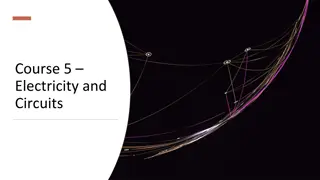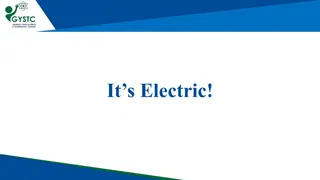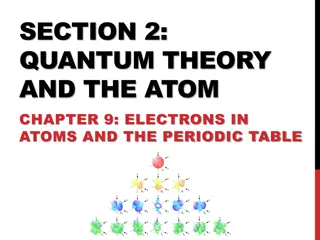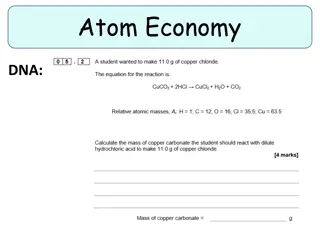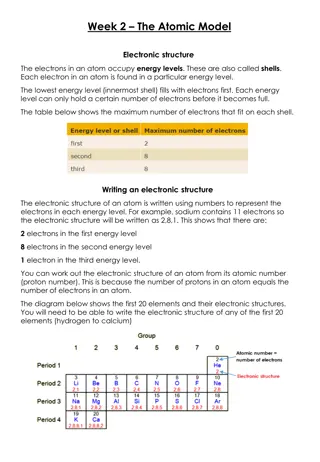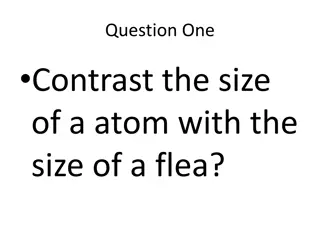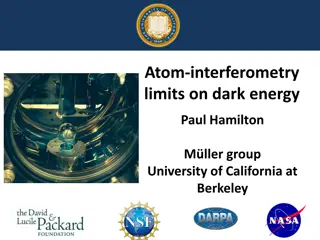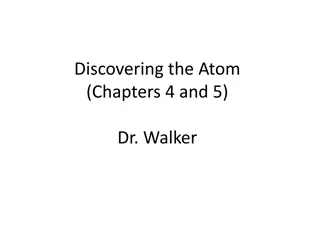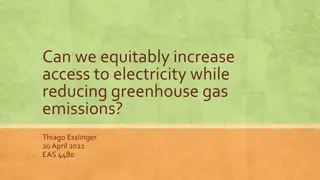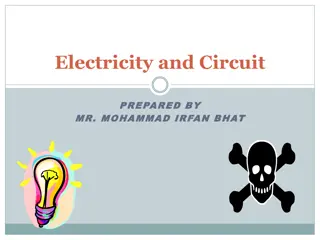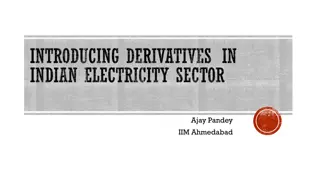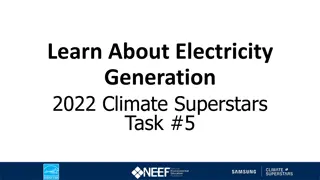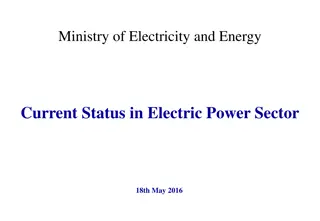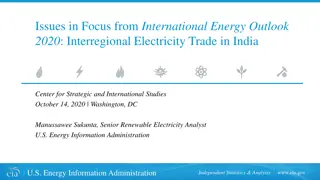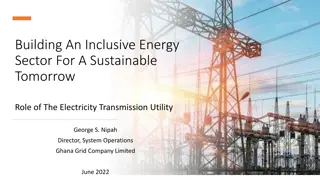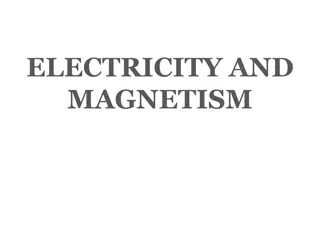Biophysics: Basics of Electricity and Atom
Electricity powers technology all around us, from cell phones to lights. Understanding electricity involves examining how electric charge flows, starting at the atomic level with electrons, protons, and neutrons in atoms. Charge carriers like electrons and protons play a crucial role in the movement of charge, leading to the generation of electricity. The concept of valence electrons and the electrostatic force are key components in comprehending the behavior of electricity in various devices.
Download Presentation

Please find below an Image/Link to download the presentation.
The content on the website is provided AS IS for your information and personal use only. It may not be sold, licensed, or shared on other websites without obtaining consent from the author.If you encounter any issues during the download, it is possible that the publisher has removed the file from their server.
You are allowed to download the files provided on this website for personal or commercial use, subject to the condition that they are used lawfully. All files are the property of their respective owners.
The content on the website is provided AS IS for your information and personal use only. It may not be sold, licensed, or shared on other websites without obtaining consent from the author.
E N D
Presentation Transcript
(Electricityand Magnetism)1stCLASS 2024-2025 Dr. Sami Abd AlhusseinHabana Biophysics: Lecture(1) What is Electricity? Electricity is all around us--powering technology like our cell phones, computers, lights, soldering irons, and air conditioners Electricity is a natural phenomenon that occurs throughout nature and takes many different forms. Our goal is to understand how electricity flows from a power source through wires, lighting up LEDs, spinning motors, and powering our communicationdevices. Electricity is briefly defined as the flow of electric charge. Where do the charges come from? How do we move them? Where do they move to? How does an electric charge cause mechanicalmotion or make things light up? To understand the fundamentals of electricity, we need to begin by focusing in on atoms, one of the basics of life and matter. Atoms of many types can combine to make molecules, which build the matter we can physicallysee and touch. Building Blocksof Atoms An atom is built with a combination of three distinct particles: electrons, protons, and neutrons. Each atom has a center nucleus, where the protons and neutrons are densely packed together. Surrounding the nucleus are a group of orbiting electrons. Al-Mustaqbal University CollegeofScience Forensic Evidence department [
Biophysics: Lecture (1) (BASICS OF ELECTRICITY) 1stCLASS 2023-2024 Dr. Sami AbdAlhussein A very simple atom model. It's not to scale but helpful for understanding how an atom is built. A core nucleus of protons and neutrons is surrounded by orbiting electrons. Every atom must have at least one proton in it. The number of protons in an atom is important, because it defines what chemical element the atom represents. For example, an atom with just one proton is hydrogen, an atom with 29 protons is copper, and an atom with 94 protons is plutonium. This count of protons is called the atom's atomic number. As in the Bohr atom model below, a nucleus with 29 protons (making it a copper atom) is surrounded by an equal number of electrons. 2 Al-Mustaqbal University CollegeofScience MedicalPhysicsDepartment
Biophysics: Lecture (1) (BASICS OF ELECTRICITY) 1stCLASS 2023-2024 Dr. Sami AbdAlhussein The atom's electrons aren't all forever bound to the atom. The electrons on the outer orbit of the atom are called valence electrons. With enough outside force, a valence electron can escape orbit of the atom and become free. Free electrons allow us to move charge, which is what electricity is all about. Flowing Charges Charge is a property of matter--just like mass, volume, or density. It is measurable. You can measure how much charge it has. The key concept with charge is that it can come in two types: positive (+) or negative (-). In order to move charge we need charge carriers, and that's where our knowledge of atomic particles--specifically electrons and protons--comes in handy. Electrons always carry a negative charge, while protons are always positively charged. Neutrons are neutral and have no charge. Both electrons and protons carry the same amount of charge, just a different type. A lithium atom (3 protons) model with the charges labeled. The charge of electrons and protons is important, because it provides us the means to exert a force on them. 3 Al-Mustaqbal University CollegeofScience MedicalPhysicsDepartment
Biophysics: Lecture (1) (BASICS OF ELECTRICITY) 1stCLASS 2023-2024 Dr. Sami AbdAlhussein ElectrostaticForce Electrostatic force (also called Coulomb's law) is a force that operates between charges. It states that charges of the same type repel each other, while charges of opposite types are attracted together. Opposites attract, and likes repel. The amount of force acting on two charges depends on how far they are from each other. The closer two charges get, the greater the force (either pushing together, or pulling away)becomes. MakingChargesFlow We now have all the tools to make charges flow. Electrons in atoms can act as our charge carrier, because every electron carries a negative charge. If we can free an electron from an atomand force it to move, we can create electricity. Electrons orbit at varying distances from the nucleus of the atom. Electrons closer to the nucleus feel a much stronger attraction to the center than those in distant orbits. The outermost electrons of an atom are called the conduction electrons; these require the least amount of force to be freed from an atom. 4 Al-Mustaqbal University CollegeofScience MedicalPhysicsDepartment
Biophysics: Lecture (1) (BASICS OF ELECTRICITY) 1stCLASS 2023-2024 Dr. Sami AbdAlhussein Using enough electrostatic force on the valence electron--either pushing it with another negative charge or attracting it with a positive charge--we can eject the electron from orbit around the atom creating a free electron. Now considera copperwire: matterfilled with countless copperatoms. Asour free electron is floating in a space between atoms, it has pulled and prodded by surrounding charges in that space. The free electron eventually finds a new atom to latch on to; in doing so, the negative charge of that electron ejects another valence electron from the atom. Now a new electron is drifting through free space looking to do the same thing. This chain effect can continue and on to create a flow of electrons called electric current. A very simplifiedmodel of charges flowing through atoms to make current. Conductivity Some elemental types of atoms are better than others at releasing their electrons. To get the best possible electron flow we want to use atoms, which don't hold very tightly to their valence electrons. An element's conductivity measures how tightly bound an electron is to an atom. Elements with high conductivity, which have very mobile electrons, are called conductors. These are the types of materials we want to use to make wires and other components, which aid in electron flow. Metals like copper, silver, and gold are usually our top choices for good conductors. Elements with low conductivity are called insulators. Insulators serve a very important purpose: they prevent the flow of electrons. Popular insulators include glass, rubber, plastic,and air. 5 Al-Mustaqbal University CollegeofScience MedicalPhysicsDepartment
Biophysics: Lecture (1) (BASICS OF ELECTRICITY) 1stCLASS 2023-2024 Dr. Sami AbdAlhussein Staticor Current Electricity Before we get much further, let us discuss the two forms electricity can take: static or current. In working with electronics, current electricity will be much more common, but staticelectricity is important to understandas well. StaticElectricity Static electricity exists when there is a build-up of opposite charges on objects separated by an insulator. Static (as in "at rest") electricity exists until the two groups of opposite charges can find a path between each other to balance the system out. Static discharges can be harmful depending on what medium the charges travel through and to what surfaces the charges are transferring. Charges equalizing through an air gap can result in a visible shock as the traveling electrons collide with electrons in the air, which become excited and release energy in the form of light. Spark gap igniters are used to create a controlled static discharge. Opposite charges build up on each of the conductors until their attraction is so great charges can flow through the air. 6 Al-Mustaqbal University CollegeofScience MedicalPhysicsDepartment
Biophysics: Lecture (1) (BASICS OF ELECTRICITY) 1stCLASS 2023-2024 Dr. Sami AbdAlhussein Static electricity also familiarly exists when we rub balloons on our head to make our hair stand up. In each case, friction from rubbing different types of materials transfers electrons. The object losing electrons becomes positively charged, while the object gaining electronsbecomes negatively charged. Current Electricity This form of electricity exists when charges are able to constantly flow. As opposed to static electricity where charges gather and remain at rest, current electricity is dynamic,charges are alwayson the move. Circuits If you have a wire full of copper atoms and want to induce a flow of electrons through it, all free electrons need somewhere to flow in the same general direction.Copper is a great conductor, perfect for making charges flow. If a circuit of copper wire is broken, the charges can't flow through the air, which will also prevent any of the charges toward the middle from going anywhere. On the other hand, if the wire were connected end-to-end, the electrons all have a neighboring atom and can all flow in the same general direction. ElectricFields Fields can't be seen as they don't have a physical appearance, but the effect they have is very real. We're all subconsciously familiar with one field in particular: Earth's gravitational field, the effect of a massive body attracting otherbodies. Earth's gravitational field can be modeled with a set of vectors all pointing into the center of the planet; regardless of where you are on the surface, you'll feel the force pushing you towards it. 7 Al-Mustaqbal University CollegeofScience MedicalPhysicsDepartment
Biophysics: Lecture (1) (BASICS OF ELECTRICITY) 1stCLASS 2023-2024 Dr. Sami AbdAlhussein The strength or intensity of fields isn't uniform at all points in the field. The further you are from the source of the field the less effect the field has. The magnitude of Earth's gravitational field decreases as you get further away from the center of the planet. ElectricFields Electric fields (e-fields) are an important tool in understanding how electricity begins and continues to flow. Electric fields describe the pulling or pushing force in a space between charges. Compared to Earth's gravitational field, electric fields have one major difference: while Earth's field generally only attracts other objects of mass, electric fields push charges away just as often as they attract them. The direction of electric fields is always defined as the direction a positive test charge would move if it were dropped in the field. The test charge has to be infinitely small, to keep its charge from influencingthe field. If you dropped a positive test charge near a negative charge, the test charge wo uld be attracted towards the negative charge. Therefore, for a single, negative charge we draw our electric field arrows pointing inward at all directions. That sametest charge dropped near another positive charge would resultinanoutward repulsion,which means we draw arrows going out of the positive charge. 8 Al-Mustaqbal University CollegeofScience MedicalPhysicsDepartment
Biophysics: Lecture (1) (BASICS OF ELECTRICITY) 1stCLASS 2023-2024 Dr. Sami AbdAlhussein The electric fields of single charges. A negative charge has an inward electric field because it attracts positive charges. The positive charge has an outward electric field,pushing away like charges. Voltage Voltage (denoted V), sometimes referred to as "electrical potential difference" or "electro-motive force" is the difference in the electrical potential energy per unit of charge between two positions in space. It tells us the amount of energy that is required to separate two charged materials some distance. To give an example, if it requires 9 Joules (J) of energy to separate 3 Coulombs (C) of electrical charge, the resulting electrical potential difference (which is to say voltage) would be 3 Volts (V). Accordingly,the equationfor voltageis: V = W/Q Where V: Voltage W: Energy (or Work) Q:Charge Voltage is also the amount of electrical potential energy per unit of charge contained by the charges once they have been separated. Therefore, if 3 C of charge travels across the 3 V of electrical potential difference, that represents 9 J of electrical kinetic energy available to do work on some other system. 9 Al-Mustaqbal University CollegeofScience MedicalPhysicsDepartment
1stCLASS 2023-2024 (BASICS OF ELECTRICITY) Biophysics: Lecture (1) Dr. Sami AbdAlhussein This decrease in voltage as charge moves from a position of higher electrical potential energy to a position of lower electrical potential energy is referred to as a "voltagedrop." Current Current (denoted I) is the rate at which charge is flowing. It is defined as the amount of charge that passes a point in a second. For example, if 3 Coulombs of charge pass a single point in a wire over the course of 2 seconds, there exists a current of 1.5 Amperes (A) in the system. I = Q/t Where I: Current Q: Charge t: Time The relationship between current and voltage is integral in understanding how much power is "developed" in a system, that is to say, how much electrical power is generated and dissipated. Resistance Resistance is the opposition to electrical current in a material. To put it another way, resistance is the inverse of a material's ability to conduct electricity. Resistance is an important concept to understand when discussing electricity because it dictates how quickly charge will flow through a circuit and therefore how much current will exist. Ohm's Law Ohm's Law gives us the mathematical relationship between voltage, current and resistanceandisoneofthemostfundamentaltenantsinunderstandingelectricity: V = IR Where V: Voltage R:Resistance I:Current 10 Al-Mustaqbal University CollegeofScience MedicalPhysicsDepartment


